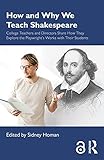How and Why We Teach Shakespeare : College Teachers and Directors Share How They Explore the Playwright’s Works with Their Students
Material type: ArticleLanguage: English Publication details: Taylor & Francis 2019Description: 1 electronic resource (230 p.)ISBN:
ArticleLanguage: English Publication details: Taylor & Francis 2019Description: 1 electronic resource (230 p.)ISBN: - 9780429283192
Open Access star Unrestricted online access
In How and Why We Teach Shakespeare, 19 distinguished college teachers and directors draw from their personal experiences and share their methods and the reasons why they teach Shakespeare. The collection is divided into four sections: studying the text as a script for performance; exploring Shakespeare by performing; implementing specific techniques for getting into the plays; and working in different classrooms and settings. The contributors offer a rich variety of topics, including: working with cues in Shakespeare, such as line and mid-line endings that lead to questions of interpretation seeing Shakespeare’s stage directions and the Elizabethan playhouse itself as contributing to a play’s meaning using the "gamified" learning model or cue-cards to get into the text thinking of the classroom as a rehearsal playing the Friar to a student’s Juliet in a production of Romeo and Juliet teaching Shakespeare to inner-city students or in a country torn by political and social upheavals. For fellow instructors of Shakespeare, the contributors address their own philosophies of teaching, the relation between scholarship and performance, and―perhaps most of all―why in this age the study of Shakespeare is so important.
All rights reserved http://oapen.org/content/about-rights
English
There are no comments on this title.

